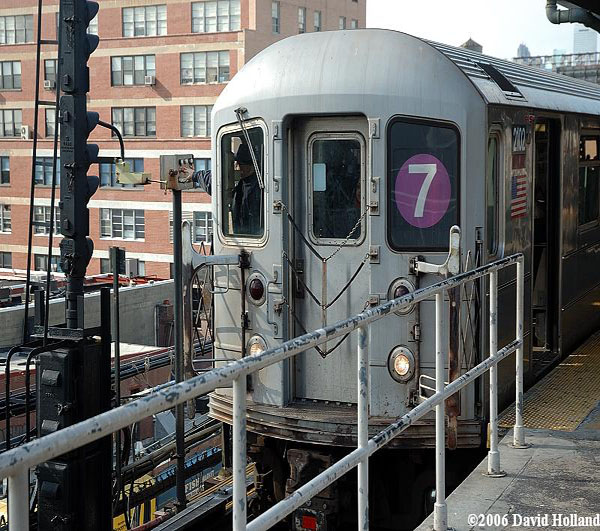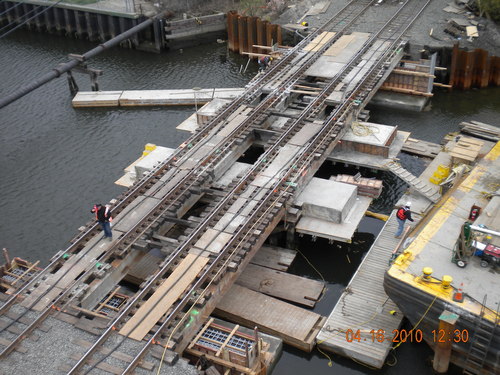MTA Board Approves Capital Construction Plan
Earlier today, the MTA Board held its monthly meeting & the biggest news to come from it was the approval of the $26.3 billion 2010 – 2014 Capital Construction Plan. The plan which made news 5 days ago when the MTA announced it came up with $2B in savings will now be sent to Albany for approval. NY1 had more in this brief report:
The Metropolitan Transportation Authority board voted today to send its Capital Construction Plan to Albany for final approval.
The $26.3 billion five-year program goes from 2010-2014 and is separate from the operating budget.
It includes plans for new subway cars, station improvements, new signals on the Number 7 subway line, new environmentally-friendly buses and larger-scale projects including the Second Avenue subway line and the East Side access for the Long Island Rail Road.
The first two years of the plan are already paid for, but the last three, which totals $10 billion, is not. As a result, MTA officials say there is still work to be done to secure those resources.
Click here for the complete report.
xoxo Transit Blogger
You might enjoy reading these related entries:- MTA Approves 2015-2019 Capital Program
- MTA Statement On Capital Program Deferrals
- MTA Chairman Statement On Capital Program
- $210 Million Grant Approved For LIRR East Side Access Project
- MTA Releases Draft Of 2010-14 Capital Program
Track Supervisor Death Could’ve Been Avoided

The spot where James Knell met his untimely demise. Photo courtesy of Costanza for the New York Daily News.
Two days ago, I had to unfortunately write an entry about the death of 45 year old MTA NYC Transit Track Supervisor James Knell. His untimely demise came after he came in contact with an electrified third rail at the Beach 90th Street station which is currently under renovations.
Today’s edition of the New York Daily News has a followup report on this tragic accident which states that the death could have been avoided if MTA NYC Transit safety regulations were followed. Clare Trapasso & Pete Donohue have more:
The track supervisor who tripped and fell to his death on a third rail Monday apparently shouldn’t have been working in that morning’s wet weather, union officials said.
NYC Transit safety regulations state workers shouldn’t be near the electrified third rail if it is raining or the area is rain-slicked, as it was when track supervisor James Knell died along the Rockaway Shuttle line, according to Transport Workers Union Local 100 President John Samuelsen.
“How could this happen?” father-in-law Gregory Odette said. “They shouldn’t have been working in the rain. I don’t understand. Somebody made a mistake.”
Track workers twice were pulled from tracks during heavy rainfall before the 4:30 a.m. tragedy, sources said.
Click here for the complete report.
If things could not get any worse, this news has come out. Death of a loved one is arguably the hardest emotion to deal with. The pain & grief of this must have multiplied greatly for his loved ones after finding out it could have been avoided. I feel it is safe to assume more will be coming out about this pending the conclusion of the ongoing investigation. I will definitely be keeping an eye on this story.
xoxo Transit Blogger
You might enjoy reading these related entries:- Knell Family To Sue NYC For $50 Million
- Internal Report Reveals Action Before Death
- MTA NYCT Track Supervisor Dies This Morning
- More Safety Lapses……
- Subway Supervisor Had A Role In Transit Worker Death
NYC’s Turn To Shell Out The Cash

Flushing-Main Street bound 7 train at Queensboro Plaza. Resized photo courtesy of Eye On Transit.
The much maligned 7 line extension is a topic I have blogged about extensively since 2006. For those who don’t recall, I was strongly against this project as I accurately feel there are more pressing projects that need to be done in terms of expansions to our system.
The project has once again made the news as a report in today’s New York Daily News looks into how NYC will have to shell out $46M for this project next year. Adam Lisberg has more:
The city will spend $46 million next year on a subway to nowhere – the first time taxpayers have put cash toward Mayor Bloomberg’s dream of extending the 7 train to the far West Side.
Bloomberg budgeted $300 million for the subway project over the past five years but never spent any of it. Developer fees and investment income had paid the interest on bonds financing the $2.1 billion extension.
Next year, however, Hudson Yards Infrastructure Corp. President Alan Anders expects the city will cover half the $97.5 million interest cost.
“We’re running out of investment earnings,” Anders told the Daily News. “A lot of it will still be covered – maybe half.”
He said the project is on time and under budget, with 60% of the contracts already signed. A proposed second station at 41st St. and 10th Ave. was abandoned to save money, though the Real Estate Board of New York has sought federal funds for it.
Click here for the complete report.
Every time I read or write about this report, I get so angry. I know in my heart of hearts that this project is completely unnecessary & will do next to nothing in terms of improving service or our infrastructure as a whole. All this does is satisfy the obsession of a power hungry Mayor while feeding money towards his cronies. Typical nonsense like this is just one of the many reasons our system is nowhere near where it should be in terms of usefulness & condition for starters.
xoxo Transit Blogger
You might enjoy reading these related entries:- Poor Hells Kitchen Never Stood A Chance
- 7 Line Extension Will Be A Colossal Mistake
- City Officials Continue To Insult The MTA
- SAS To Receive $79M In Stimulus Money
- MTA Statement On 10th Av Station For 7 Line Ext.
Exciting New Transit Apps Are On The Way
In this day & age, technology arguably plays the biggest role in our lives. This is especially true when it comes the plethora of smart phones on the market which seem to be able to do just about everything but brush your teeth for you!
The world of public transportation has seen a huge amount of user friendly applications come out. Up until recently, the MTA was known for giving the brutally cold shoulder to developers as they did not make their data freely available. As some developers could attest, you either had to shell out big bucks or go through what seemed like a never ending process to get anywhere.
However under the new leadership of MTA CEO Jay Walder, the MTA has joined many other agencies in making their data freely available. Here is a report from AMNY’s Heather Haddon on this very subject:
Imagine being able to find out exactly where a bus is see through a tweet on your phone? Or clicking to find out if they’ve finally fixed that busted escalator at your station?
Soon, straphangers can expect a bonanza of new transit apps offering plenty of gee-whiz services, adding to an already rich collection that is changing the way New Yorkers commute.
“It’s getting bigger and bigger,” said Norman Scherer, 53, who attends periodic beer and pizza Meetup fests for developers making transit apps. “They have attracted all these crazy geeky guys who love making apps.”
What’s driving the explosion is the MTA itself. Previously, developers got the cold shoulder from the agency, having to pay big bucks for data or request it through a gruelingly slow process. MTA CEO Jay Walder did a 180 in January, with the agency joining 110 other transit agencies across the world making its gold mine of transit data freely available, according to City-Go-Round, a group pressing for open source data.
Click here for the complete report.
I never understood the previous stance of the MTA when it came to making their data available to developers. In this day & age, technology is a huge part of our everyday lives. For the millions who ride the system daily, user friendly apps that could help their commute should have been openly accepted by the MTA. It is a shame that it took so long for them to realize this. However I will try to focus on the positive in that they did & many will benefit in the long run.
xoxo Transit Blogger
You might enjoy reading these related entries:- MTA Debuts New Website
- MTA Adds L Line Arrivals To App
- MTA Announces Bus Time Roll Out Plan
- CooCoo Cancels Texting Service
- MTA Adds Real-Time To Weekender App
No Long Beach Branch Service This Weekend

Installing pre-cast abutments at the Hog Island Channel Bridge. Photo courtesy of the MTA Long Island Rail Road.
Once again, service on the MTA LIRR’s Long Beach line will be suspended this weekend due to the continued construction of new bridges over Powell Creek & Hog Island Channel. Here are the complete details courtesy of a press release issued a few minutes ago by the Long Island Rail Road:
Buses will replace train service for Long Island Rail Road customers traveling between Long Beach and Valley Stream the weekend of Saturday, May 1 and Sunday, May 2 as work continues on the construction of two new railroad bridges over Powell Creek and Hog Island Channel.
The $24.5 million project, which is funded through the MTA Capital Budget and federal grants, will also require another train outage on the weekend of May 15-16. The Railroad’s goal is to complete the installation of both bridges before Memorial Day.
Eastbound: Customers will transfer to buses at Valley Stream for stations Lynbrook through Long Beach. Customers should allow up to 34 minutes of additional travel time.
Westbound: Customers will board buses at stations Long Beach through Lynbrook bound for Valley Stream, where they will transfer to trains to complete their trip. Buses will depart up to 33 minutes earlier than scheduled train times
Both the Powell Creek Bridge (located between the LIRR’s East Rockaway and Oceanside Stations) and the Hog Island Channel Bridge (located between Oceanside and Island Park Stations) were built in the 1920s, and have served the LIRR well for nearly 90 years. These two bridges are being replaced as part of the Railroad’s ongoing efforts to modernize its infrastructure and ensure safe and reliable service for our customers and neighbors for decades to come.
The existing Powell Creek and Hog Island Bridges are open-deck wooden and steel structures supported by wooden piles through which water is visible below. These structures will be removed and replaced with pre-cast concrete structures, supported by reinforced concrete-filled, steel pipe piles, which will provide safer, closed-deck concrete roadbeds.
The project will also alleviate a recurring flooding condition at Powell Creek Bridge, which has at times led to delays and temporary service suspensions, by raising the elevation of the bridge by approximately one foot. Bridge walkways will also be installed at both locations to make it safer for LIRR employees.
xoxo Transit Blogger
You might enjoy reading these related entries: